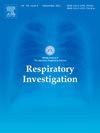Biologics treatment for eosinophilic chronic rhinosinusitis complicated by bronchial asthma: Narrative review
IF 2.4
Q2 RESPIRATORY SYSTEM
引用次数: 0
Abstract
There are 4 subtypes of chronic rhinosinusitis (CRS): eosinophilic CRS with nasal polyps (ECRSwNP), ECRS without NPs (ECRSsNP), non-ECRSwNP, and non-ECRSsNP. Most ECRS cases are categorized as ECRSwNP, and the number of patients with ECRSwNP has recently increased. ECRS is associated mainly with helper T-cell type 2 inflammation and eosinophils. Recently, Interleukin-25, -33, or TSLP, helper T-cell type 17, and Group 2 innate lymphoid cells have also been shown to be involved in the molecular mechanism of ECRS. ECRS can lead to several complications including bronchial asthma and/or aspirin intolerance. Conventionally, surgery and corticosteroids have been used to treat ECRS, but biologics have since been applied. Mepolizumab, benralizumab, and tezepelumab have been reported to improve asthma complicated by NPs more than asthma uncomplicated by NPs. Omalizumab, mepolizumab, benralizumab, and dupilumab have been reported to significantly improve Sinonasal Outcome Test-22 scores, nasal polyp scores, and nasal congestion severity in phase III trials. Benralizumab, dupilumab, and tezepelumab have been reported to improve both ECRS and complicated bronchial asthma.
嗜酸性慢性鼻窦炎合并支气管哮喘的生物制剂治疗:叙述性综述。
慢性鼻窦炎(CRS)有4种亚型:嗜酸性CRS伴鼻息肉(ECRSwNP)、不伴鼻息肉(ECRSsNP)、非ECRSwNP和非ECRSsNP。大多数ECRS病例被归类为ECRSwNP,并且最近ECRSwNP患者的数量有所增加。ECRS主要与辅助性t细胞2型炎症和嗜酸性粒细胞相关。最近,白细胞介素-25、-33或TSLP、辅助性t细胞17型和2组先天淋巴样细胞也被证明参与了ECRS的分子机制。ECRS可导致多种并发症,包括支气管哮喘和/或阿司匹林不耐受。传统上,手术和皮质类固醇已被用于治疗ECRS,但生物制剂已被应用。据报道,Mepolizumab、benralizumab和tezepelumab对NPs合并哮喘的改善效果优于未合并NPs的哮喘。据报道,在III期临床试验中,Omalizumab、mepolizumab、benralizumab和dupilumab可显著改善Sinonasal Outcome Test-22评分、鼻息肉评分和鼻塞严重程度。据报道,Benralizumab、dupilumab和tezepelumab可改善ECRS和并发支气管哮喘。
本文章由计算机程序翻译,如有差异,请以英文原文为准。
求助全文
约1分钟内获得全文
求助全文

 求助内容:
求助内容: 应助结果提醒方式:
应助结果提醒方式:


